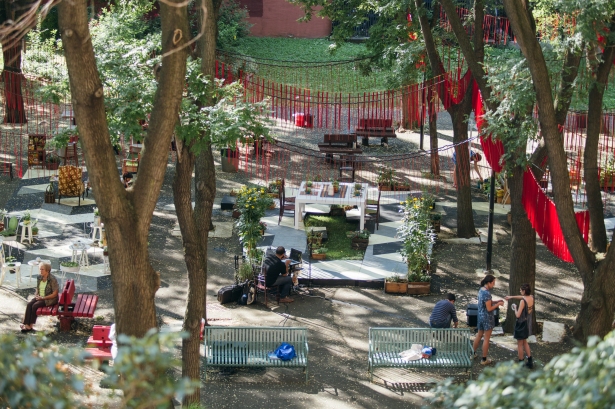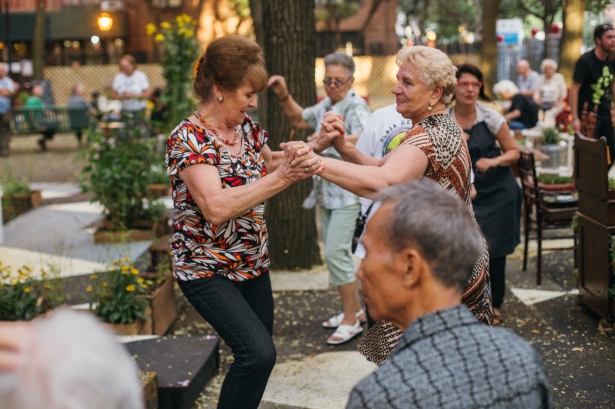This post comes from Ecoscenography
Pia Guilliatt graduated from the Victorian College of the Arts (VCA) in 2017 with a Bachelor of Fine Arts (Production) majoring in Design Realisation. She is set and costume designer and artist with an interest in sustainable and community theatre and is particularly fascinated by immersive theatrical spaces where different artistic disciplines intersect and collide. She relishes in the challenge of working within the parameters of environmental sustainability in her work, from model making and sculpting to costume and set design. It was Pia’s interest in sustainable design that led her to joining me in New York to work on the fifth Living Stage as part of her studies last year. Its just over a year since we were in the US, and I am delighted to have the opportunity to share her post about The Living Stage NYC with you.
I have always had a passion for the environment and a strong desire to make a positive impact in whatever area I am working in. I believe that the role of art is to educate and spread awareness about significant social and political issues and to actively partake in exploring solutions to these problems. It is not simply enough make a show about climate change if the creation process is still having a negative effect on the environment through the use of unsustainable materials and wastage. Similarly, the positive message promoted by a theatre piece that explores marginalisation of minorities in society is going to be severely diminished if the show itself is not even accessible to the group of people it supposedly represents.
As I become more and more exposed to theatre culture and practices through my studies in stage design, I have become increasingly aware of its exclusivity and general lack of engagement in environmental issues. I find it shocking, for example, that with all the information we have available about the irreversible effects of climate change, there was no acknowledgement of sustainable materials and practices or waste management anywhere in my production curriculum. For these reasons, I had become increasingly disillusioned with the theatre world and had begun questioning whether I could realistically pursue a design career if it meant sacrificing my passion for the environment. I had no idea that there were designers working specifically in the area of theatre and sustainability and had definitely never heard the term ‘ecoscenography’. So, when I came across Tanja’s work, it was like a breath of fresh air and a revival of my desire to work in this industry. She, like me (only much later in her career) had gone through a crisis of questioning the ethics of her work, which led her to instigating projects such as The Living Stage – a project which combines stage design, horticulture and community engagement to create recyclable, biodegradable, biodiverse and edible performance spaces. In 2017, I was fortunate to assist Tanja on her fifth Living Stage project in New York, which she created in collaboration with Superhero Clubhouse; New York’s premier ecological theatre company.
 The NYC Living Stage was a community project that took place in the Lower East Side of Manhattan in Meltzer Park, a small paved green space that neighbours a Seniors Centre and apartment block, both of which are owned and managed by the New York City Housing Authority (NYCHA). Instead of working within the parameters of a script or overriding artistic vision, our aim was to turn the asphalt lined park into a beautiful and thriving space that would connect and celebrate the local community through theatre and performance design.
The NYC Living Stage was a community project that took place in the Lower East Side of Manhattan in Meltzer Park, a small paved green space that neighbours a Seniors Centre and apartment block, both of which are owned and managed by the New York City Housing Authority (NYCHA). Instead of working within the parameters of a script or overriding artistic vision, our aim was to turn the asphalt lined park into a beautiful and thriving space that would connect and celebrate the local community through theatre and performance design.
 It was amazing to see how much thought went into the communications with the local seniors and children that were engaged in the project, making them feel like they were an integral part of the work, not just passive observers. This turned out to be one of the most enjoyable parts of the whole experience – chatting to locals in the park, hearing their opinions on elements of the design, getting positive feedback, and sometimes blunt criticism. These brief exchanges revealed fascinating anecdotes and snippets of untold histories.
It was amazing to see how much thought went into the communications with the local seniors and children that were engaged in the project, making them feel like they were an integral part of the work, not just passive observers. This turned out to be one of the most enjoyable parts of the whole experience – chatting to locals in the park, hearing their opinions on elements of the design, getting positive feedback, and sometimes blunt criticism. These brief exchanges revealed fascinating anecdotes and snippets of untold histories.
 Tanja’s process relies on reclaimed materials and so is by nature spontaneous and devised. One of our highlights was visiting Materials for the Arts or MFTA (a free reclaimed materials warehouse for not-for-profit arts organisations). MFTA provided us with all of the paint we needed for the floor murals, timber frames, fabric for costumes, smaller prop items and some furniture. It was also where we found our 3500 red wooden rulers that we suspended from the trees in the space. This was the very first element of the design that was installed in the space and became a source of free publicity for the event as an increasing number of people were drawn into the park by the striking scene.
Tanja’s process relies on reclaimed materials and so is by nature spontaneous and devised. One of our highlights was visiting Materials for the Arts or MFTA (a free reclaimed materials warehouse for not-for-profit arts organisations). MFTA provided us with all of the paint we needed for the floor murals, timber frames, fabric for costumes, smaller prop items and some furniture. It was also where we found our 3500 red wooden rulers that we suspended from the trees in the space. This was the very first element of the design that was installed in the space and became a source of free publicity for the event as an increasing number of people were drawn into the park by the striking scene.

 The design also included transforming various items of furniture into vessels for plants. Working with reclaimed materials, while often tricky and fraught with splinters, provided many opportunities for creativity and resourcefulness and these items proved to be both the object and inspiration for many of the design elements. The luxury of a long installation period (over several weeks), allowed us to refine and tweak elements of the design in situ.
The design also included transforming various items of furniture into vessels for plants. Working with reclaimed materials, while often tricky and fraught with splinters, provided many opportunities for creativity and resourcefulness and these items proved to be both the object and inspiration for many of the design elements. The luxury of a long installation period (over several weeks), allowed us to refine and tweak elements of the design in situ.
 Many of the last minute solutions were discovered in this final week – such as the donation of trapezoid timber platforms that we re-configured into an angular stage for the performance. The installation period also became an accidental publicity stunt and an impromptu performance in itself, as seniors and passers began to stop to watch us work. This was evidence of the unexpected joys of community engaged theatre and public art, supporting the idea that its impact can be felt not just during the celebration but also during the making of the event.
Many of the last minute solutions were discovered in this final week – such as the donation of trapezoid timber platforms that we re-configured into an angular stage for the performance. The installation period also became an accidental publicity stunt and an impromptu performance in itself, as seniors and passers began to stop to watch us work. This was evidence of the unexpected joys of community engaged theatre and public art, supporting the idea that its impact can be felt not just during the celebration but also during the making of the event.
The Living Stage was entirely successful in its goal – it brought the residents of the Senior Centre together and transformed an underutilised space into one that was bustling with activity and purpose. Tanja’s spontaneous design process proved a great learning opportunity for me, as I was able to have a genuine contribution to both the design and making process. The project introduced me to a world where the distinction between installation and performance; spectator and creator; and intention and outcome were blurred. The experience allowed me to expand my understanding of theatre arts and rethink my role as designer, artist or creator – opening up opportunities to combine my passion for sustainability with my creative skills and artistic ambitions.
All photos by Dylan River Lopez. A short film about The Living Stage NYC is available here.
The post, The Living Stage NYC by Pia Guilliatt, appeared first on Ecoscenography.
———-
Ecoscenography.com has been instigated by designer Tanja Beer – a PhD candidate at the University of Melbourne, Australia, investigating the application of ecological design principles to theatre.
Tanja Beer is a researcher and practitioner in ecological design for performance and the creator of The Living Stage – an ecoscenographic work that combines stage design, permaculture and community engagement to create recyclable, biodegradable and edible performance spaces. Tanja has more than 15 years professional experience, including creating over 50 designs for a variety of theatre companies and festivals in Australia (Sydney Opera House, Melbourne International Arts Festival, Queensland Theatre Company, Melbourne Theatre Company, Arts Centre) and overseas (including projects in Vienna, London, Cardiff and Tokyo).
Since 2011, Tanja has been investigating sustainable practices in the theatre. International projects have included a 2011 Asialink Residency (Australia Council for the Arts) with the Tokyo Institute of Technology and a residency with the Royal Central School of Speech and Drama (London) funded by a Norman Macgeorge Scholarship from the University of Melbourne. In 2013, Tanja worked as “activist-in-residence†at Julie’s Bicycle (London), and featured her work at the 2013 World Stage Design Congress (Cardiff)
Tanja has a Masters in Stage Design (KUG, Austria), a Graduate Diploma in Performance Making (VCA, Australia) and is currently a PhD candidate at the University of Melbourne where she also teaches subjects in Design Research, Scenography and Climate Change. A passionate teacher and facilitator, Tanja has been invited as a guest lecturer and speaker at performing arts schools and events in Australia, Canada, the USA and UK. Her design work has been featured in The Age and The Guardian and can be viewed at www.tanjabeer.com
Powered by WPeMatico


